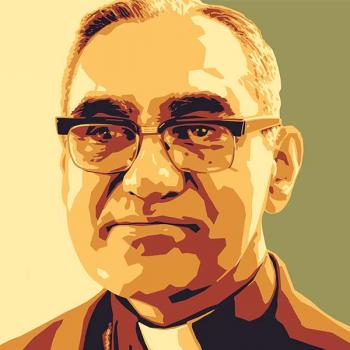I had never heard of Archbishop Oscar Romero until that day in March 1999. I was with the University of Dallas’ Alternative Spring Break program in Duran, Ecuador. We were hunkered down in the mission house because the whole country was exploding with protests. The poor were tired of being hungry. Tired of drinking sewage water from the river. Tired of being poor.
It was my first time out of the USA and I hadn’t even realized where Ecuador was on the map. I didn’t know anything about other countries and their political situations. I was a typical American girl. That night as the country exploded, the US Embassy closed its doors and evacuated, the Ecuadoran military was in the streets. The sole bridge from Duran to Guayaquil that could take us to the airport was closed. Ecuador’s President addressed the nation from his home in Miami, FL. So we listened to what he had to say and then we watched the movie “Romero.” And it was personal. We felt like we were in that movie. The poverty scenes looked exactly like where we were at. That movie and the situation we were in completely changed my life. That man and his courage and his conversion resonated deep within me and inspired me. I came home from Ecuador a changed woman. I read everything I could on Romero. I read his Pastoral Letters, I read every book written on him and wrote research papers on him for my Theology classes at UD.
When I served my mission in Costa Rica with Caritas de Costa Rica after college, I raided Caritas’ dusty library. In them, I found first hand accounts from El Salvadoran and Guatemalan refugees who had fled the wars in the 80s. In them, I found pictures of Romero with Costa Rica’s Bishops after a meeting with them. It was incredible. I begged the office to let me have them. Intelligently, they said “NO!” Really, those accounts and letters and pictures need to be in a university library somewhere. They are priceless. I read the ENTIRE library because I knew when I left I would never see them again. I cherished those photos of the martyr. My favorite one was him with Archbishop Gerardi who would also become a martyr in 1996. There they were in 1979. Could they have ever imagined they would be Saints?
The Caritas Office knew I had a devotion to Romero and they surprised me one day with a trip. Our driver, Rafa, covered my eyes and took me in a Caritas office in Eastern Costa Rica near a Dole banana plantation. I was to teach a human rights class the next day to the Nicaraguan workers who lived in slave like conditions on the plantation. I had no idea what to expect. When I walked in, there a mural of Archbishops Romero and Gerardi jumped out at me. It was incredible. It looked just like them from the pictures I had seen. Twenty years after Romero’s martyrdom and five years after Gerardi’s, the people loved them. Had devotions to them, and asked for their intercessions.
I was to make a pilgrimage to Romero’s tomb in January of 2001, but El Salvador was rocked with devastating earthquakes so I couldn’t go. I was too busy raising funds to help them recover. One day, I will go. After reading his works, I feel like I know him and wish that I did.












